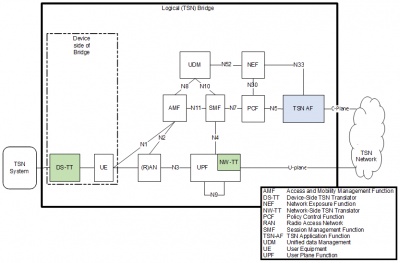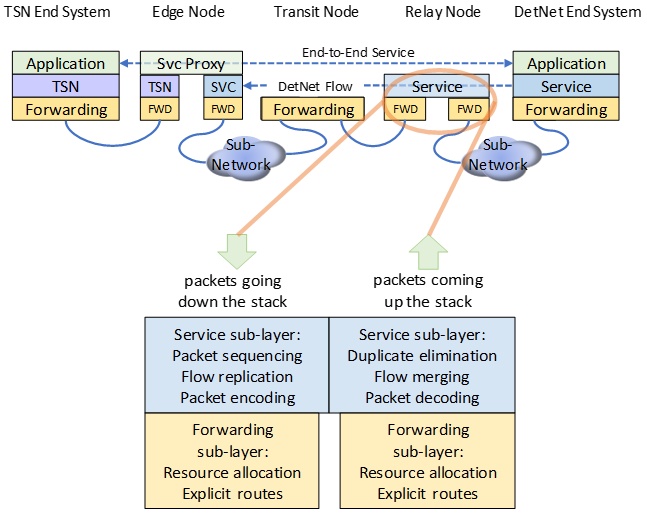Talk about the two or three things about deterministic networks

The IETF is working to provide deterministic services
through IP routers and wireless networks in the Deterministic Network (DetNet)
and RAW working groups.

For many emerging services and applications, low latency in
the network is particularly important, such as drones, industrial automation,
and self-driving cars. The International Standards Organization is currently
developing new technologies to meet the requirements of these deterministic
applications.
IEEE 802.1 is working to support deterministic Ethernet
services in its Time Sensitive Networking (TSN) task group. 3GPP is committed
to providing deterministic 5G to support ultra-reliable and low-latency
communication (URLLC) usage scenarios. The IETF is working to provide
deterministic services through IP routers and wireless networks in the
Deterministic Network (DetNet) and RAW working groups.
The deterministic network provides a deterministic delay on
the basis of each deterministic flow. The data flow of each deterministic flow
is transmitted within a certain bounded delay and low delay variation
constraints. The deterministic network aims to achieve zero data loss for all
allowed deterministic flows, and may reject or lower the priority of certain
flows to ensure the transmission of high-priority flows. The deterministic
network supports a wide range of applications, and each application can have
different QoS requirements.
In traditional networks, achieving lower latency means
discarding more packets (or requiring a lot of over-configuration). In the case
of deterministic services, the goal is to solve the long tail problem and
provide bounded delays, see Figure 1.

IEEE 802.1 Delay Sensitive Network (TSN)
Standardization
The IEEE 802.1 Working Group (WG) focuses on standards and
practices in the following areas: (1) 802 LAN/MAN architecture, (2) 802 LAN,
interconnection between MAN and other WANs, (3) 802 Security, (4) 802 overall
network management, and the protocol layer above the MAC and LLC layers.
The Time Sensitive Network (TSN) Task Group (TG) of the IEEE
802.1 Working Group is responsible for the deterministic services of IEEE 802
networks, including:
·
·
·
·
The TSN task force evolved from the Audio Video Bridging
(AVB) task group.
TSN standards and projects are divided into three groups:
1) Basic technology (such as 802.1CB, 802.1Qbv, etc.)
2) Configuration (such as 802.1Qcp, 802.1Qcc, etc.)
3) Configuration files (for example, 802.1BA, 802.1CM,
IEC/IEEE 60802, etc.)

Figure 2: IEEE 802.1 TSN components
TSN Function
IEEE 802.1 defines TSN flow as a unidirectional data flow
from Talker to one or more Listeners. In the forwarding process of the bridge,
QoS functions are applied to the frames of the TSN flow, such as filtering and
policing, shaping and queuing.
IEEE 802.1 TSN TG defines a wide range of TSN functions.
This article only discusses some functions. The main medium of TSN is IEEE
802.3 Ethernet. Work involving wireless is also in progress, such as the 5G-TSN
integration work in 3GPP.
Scheduled Traffic (802.1Qbv) reduces the delay variation of
known time frames. This is achieved through time-based control and bridge queue
programming. Each queue is equipped with time-gates (time-gated queues), which
can only serve the queue when the "gate" is open. The door opening/closing
status changes according to a periodically repeating schedule. This feature
requires end-to-end time synchronization.
Frame Preemption (802.3br and 802.1Qbu) enables so-called
fast frames (that is, critical traffic) to suspend the transmission of
preemptible frames (that is, non-critical traffic). As a result, the delay
variation of fast traffic is reduced, and the available bandwidth that can be
preempted for traffic is increased. Frame preemption is a link-local per-hop
function, which means it is not multi-hop.
Per-Stream Filtering and Policing (802.1Qci) provides
protection to prevent traffic from violating its bandwidth allocation,
malfunctioning, participating in attacks, etc. Filtering and control decisions
can be made on a per-flow, per-priority, etc. basis.
Asynchronous Traffic Shaping (ATS) (802.1Qcr) provides zero
congestion loss and does not require time synchronization. The essence of the
ATS function is to smooth the traffic pattern by reshaping at each hop so that
urgent traffic takes precedence over less urgent or flexible traffic. ATS uses
strict priority queues.
Frame Replication and Elimination for Reliability (FRER)
(802.1CB) aims to avoid frame loss due to equipment failure. It is a 1+1 (or
1+n) redundant function per frame. No failure detection or switching mechanism
is required. FRER sends frames on the two (or more) largest disjoint paths,
then combines the streams and deletes the extra frames.
Explicit Trees by IS-IS Path Control & Reservation
(802.1Qca, RFC 7813) adds non-shortest path or explicit path forwarding, and
provides IS-IS control beyond the shortest path tree (SPT). The protocol has
not changed, only a few new sub-TLVs are defined, and existing sub-TLVs are
reused as much as possible. The concept is a hybrid software-defined network
(SDN) approach, where IS-IS provides basic functions such as topology discovery
and default paths, and one or more controllers control an explicit tree.
Stream Reservation Protocol (SRP) enhancements and
performance improvements (802.1Qcc): Provides time-sensitive network (TSN)
configuration related attributes. 802.1Qcc describes three models of TSN user
and network configuration (fully distributed, centralized network/distributed
user and fully centralized model). Each model specification defines the logical
flow of user/network configuration information between different entities in the
network.
TSN's Future Outlook
TSN standardization is still in progress. The IEC/IEEE 60802
TSN industrial automation specification is a joint project of IEC SC65C/WG18
and IEEE 802. This joint work will provide a dual marking standard that is both
an International Electrotechnical Commission (IEC) and an IEEE standard.
OPC UA is based on TSN, DetNet and 5G. Several OPC UA work
items related to TSN are in progress. One of them is the FLC (Field Level
Communications) working group, which is mainly based on the IEC/IEEE 60802
specifications and related evaluation specifications.
3GPP Supports Deterministic Transmission (URLLC)
Standardization
The three major application scenarios of 5G include enhanced
mobile broadband (eMMB), massive machine communication (mMTC), and ultra-high
reliability and low-latency communication (uRLLC). Among them, URLLC makes 5G
the best candidate to support wireless deterministic and time-sensitive
communication applications.
5G R15 introduces multiple functions, the one-way delay of
message transmission is as low as 1 millisecond, and the reliability is as high
as 99.999%. R16 adds more URLLC features to support one-way delays as low as
0.5 milliseconds and reliability as high as 99.9999%.
URLLC function
At the beginning of the R15 research, a work project was
established to study delay reduction technologies such as sub-carrier spacing,
flexible frame structure, and short time slot scheduling. As of R16, 3GPP has
successively completed the performance evaluation of URLLC use cases, the
enhancement of the physical layer channels, and the research and
standardization of URLLC and eMBB uplink multiplexing technologies, but there
are still many optimizations expected to be left to R17 for research.
5G defines a powerful transmission mode to improve the
reliability of the data and control radio channels. Multi-antenna transmission,
the use of multiple carriers, and packet duplication on independent radio links
all further improve reliability.
Time synchronization has been embedded in the cellular radio
system as an important part of its operation. The equipment is time calibrated
by the base station to compensate for their different propagation delays. The
wireless network components themselves are also time synchronized. This is a
good basis for providing synchronization for time-critical applications.
In addition to 5G RAN functions, the 5G system also provides
core network (CN) solutions for Ethernet networking and URLLC. 5G CN supports
local Ethernet Protocol Data Unit (PDU) sessions. For user plane redundancy at
the 5G system level, 5G supports the establishment of redundant user plane
paths through 5G systems including RAN, CN, and transmission networks. By using
a single user equipment (UE) with RAN dual connectivity in the terminal device
or by using multiple UEs in the terminal device, a redundant path is realized.
In addition, 5G can also provide virtual networks (5G-VN) and LAN groups to
allocate resources to members of specific groups.
All these new URLLC features of 5G provide a good design and
a solid foundation for using 5G in deterministic scenarios, and can even be
used as a stand-alone solution or part of a deterministic network.

Figure 3: System architecture view, 5GS is shown as a
deterministic node (here is TSN bridge)
Figure 3 shows the 5G system architecture, where the 5G
system is regarded as a TSN bridge. The figure specifies a new conversion
function (called DS-TT and NW-TT) for saving and forwarding user plane data
packets to eliminate jitter. The 5G system (5GS) is integrated as a bridge
connecting the TSN network . 5GS includes the TSN Translator (TT) function,
which is used to adapt 5GS to the TSN domain of the user plane and the control
plane.
The Future of URLLC
The 5G URLLC function closely matches the TSN and
deterministic network functions. Therefore, these three technologies can be
integrated to provide an end-to-end deterministic connection, that is, the
connection between the input/output device and its controller. The integration
already includes data plane support for the necessary basic bridging/routing
functions and TSN/DetNet add-on components, but the control and management
planes require further standardization work.
IETF Deterministic Network (DetNet)
Standardization
IETF DetNet WG (Working Group) belongs to the routing area
(Routing Area, RTG), which mainly studies routing protocols and signaling
protocols. It focuses on deterministic data paths running on layer 2 bridging
and layer 3 routing segments, which can provide limitations on delay, loss, and
packet jitter, as well as high reliability. The scope of DetNet WG includes:
overall architecture, data plane specification, data flow information model and
related YANG models.
There is close cooperation between IETF DetNet WG and IEEE
802.1 TSN TG.
DetNet operates at the IP/MPLS layer, and its initial scope
is to achieve deterministic protection under a single management control or
within a closed management and control group of the network.
The solution document specifies the procedures and behaviors
required for nodes supporting DetNet, and its specifications focus on
interoperable implementations. The following two data planes are defined:
• IP:
Use IP and transport protocol header information to support DetNet [RFC 8939]
• MPLS:
Use labels to support DetNet [RFC 8964
The forwarding feature is achieved by allocating network
resources (such as link bandwidth and buffer space) to the DetNet stream and
protecting data packets. The unused reserved resources can be used for the transmission
of non-DetNet data streams to realize the shared network transmission of
different priority service streams.
The following defines the forwarding parameters from the
source to the destination layer:
·
·
·
There is a difference in deterministic networks (similar to
TSN). It only focuses on the worst-case values of end-to-end delay, delay
variation, and disorder. The average or typical value is not important because
they will not affect the performance of the real-time system. ability.
Deterministic network functions:
·
·
Congestion protection means allocating resources along the
path of the DetNet flow, such as buffer space or link bandwidth.
Congestion protection eliminates congestion-related losses
through the use of appropriately designed queues, so no packets will be dropped
due to lack of buffer storage. It can also be used as a tool to reduce latency
variations, for example, to converge sensitive non-IP networks onto public IP
network infrastructure. Many functions of congestion protection require time
synchronization of deterministic network nodes. However, time synchronization
is not within the scope of deterministic network discussions because it does
not affect interoperability. Time synchronization should be provided by an
appropriate solution, for example, provided by a lower layer.
Service protection solves data packet errors and equipment
failures, such as data packet duplication and elimination (to prevent
failures), data packet encoding (to prevent data packet errors), and reordering
(to ensure sequential delivery). Service protection can be ensured through
these technologies. The PREOF defined by the deterministic network is: data
packet copy function (PRF: sending copies of the same data packet with sorting
information on multiple paths), redundancy elimination function (PEF: according
to the sorting information of the received data packet and The history record
discards duplicates), and the data packet sorting function (POF: restore the
original data packet order, because out-of-order delivery will affect the
amount of buffer at the destination to correctly process the received data). Data
packet duplication and elimination will not react to and correct the failure,
these functions are completely passive. Packet coding (also called network
coding) encodes information into multiple transmission units, uses multiple
paths to send them, and combines these units at the other end.
Explicit routing can be used to resolve the impact of
routing or bridging protocol convergence (ie, temporary interruption).
1) DetNet service sublayer: Provides DetNet services for
higher layers in the protocol stack and applications (for example, service
protection)
2) DetNet forwarding sublayer: support DetNet services in
the underlying network (for example, by providing explicit routing and
congestion protection) to DetNet flow

Figure 4: DetNet data plane protocol stack
The layer 3 equivalent of the TSN stream is called the
DetNet stream. The DetNet flow is a unique sequence of data packets that
conforms to the flow identifier and will provide deterministic network services
to it. It includes any deterministic network headers added to support the
DetNet service and forwarding sublayer.
Deterministic network-related mechanisms require two
attributes:
•
Flow-ID: Identifies the flow to which the data packet belongs
•
Sequence number: identify duplicate packets and reorder packets
The Future of Deterministic Networks
The standardization of deterministic networks is still in
progress. IETF DetNet and IEEE TSN will continue to work closely together to
ensure interoperability and simplify the implementation of deterministic
functions applicable to Layer 2 and Layer 3. For example, IEEE P802.1CBdb (FRER
Extended Stream Identification Functions) focuses on extending the fields used
for stream identification functions to arbitrary mask matching, which is
essential for the combined network scenario of combining TSN and DetNet.
Control and management plane related work is the next focus of DetNet WG.
In conclusion
In the past, packet-based networks were designed to carry
all traffic except for very delay-sensitive/real-time application traffic. Over
time, with the development of deterministic technology, packet-based networks
are also evolving to integrate support for demanding applications.
TSN, DetNet, and 5G URLLC can meet the networking
requirements of deterministic applications, and provide ultra-reliable,
low-latency connections through converged networks. TSN and DetNet (for wired)
and 5G (for wireless) technologies are perfect partners in deterministic
transmission networks. A certain degree of overall integration of these
technologies is required to provide end-to-end connectivity that meets
deterministic requirements.
For example, time synchronization between the wireless 5G
domain and the wired TSN/DetNet domain is necessary, because regardless of the
network technology connecting them, a common reference time is essential for
certain endpoints. Providing limited low latency may also require integration
between TSN, DetNet, and 5G, depending on the deterministic tools used in the
deployment. End-to-end ultra-reliability adjusts the characteristics of
necessary disjoint forwarding paths. The first step to support overall
integration is to use an SDN-based approach. The basic technologies of TSN,
DetNet, and URLLC are ready, and their combined deployment is imminent.